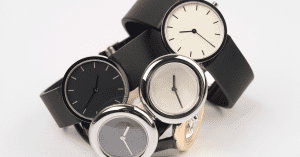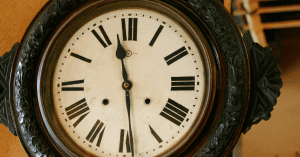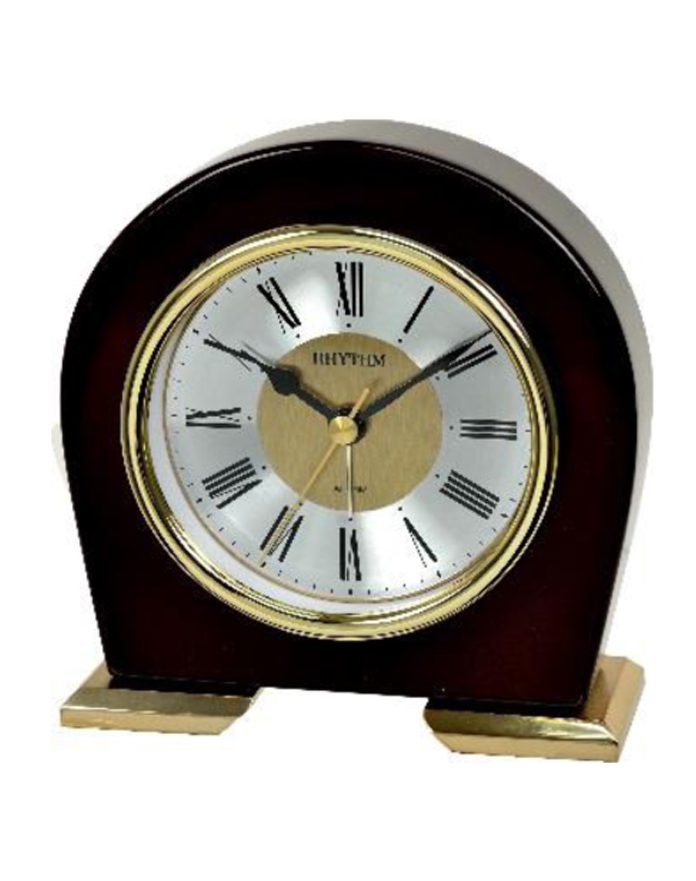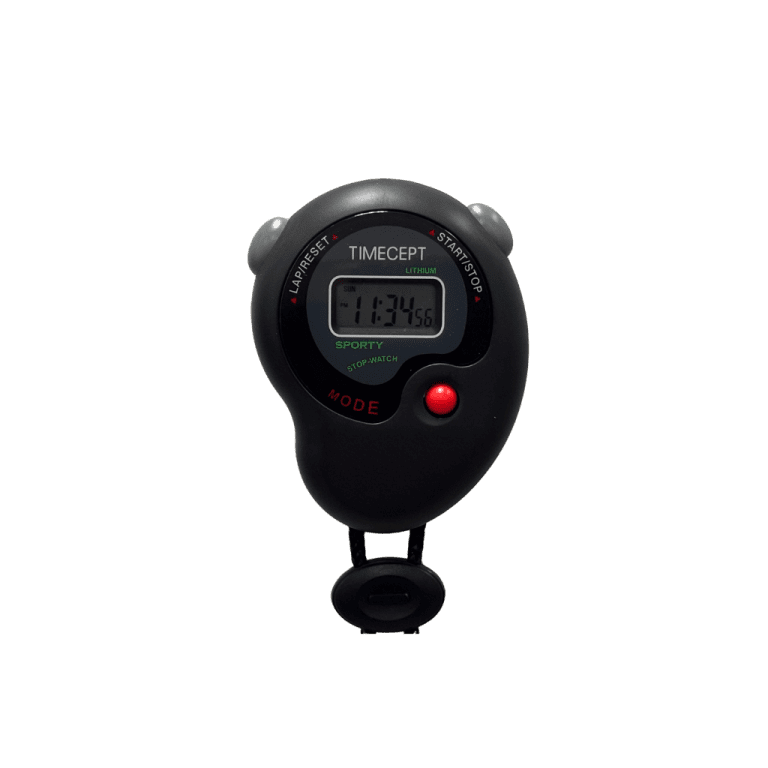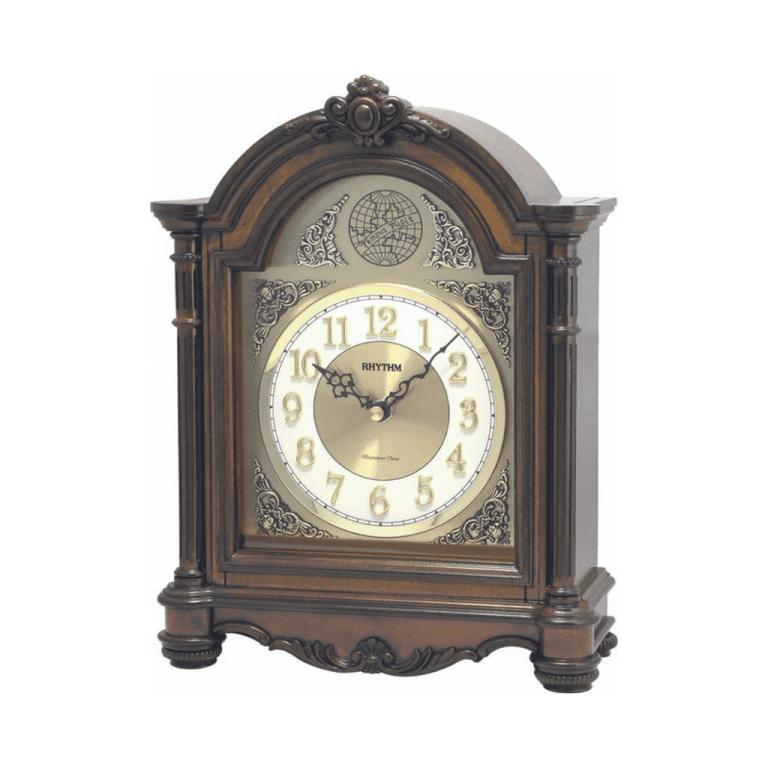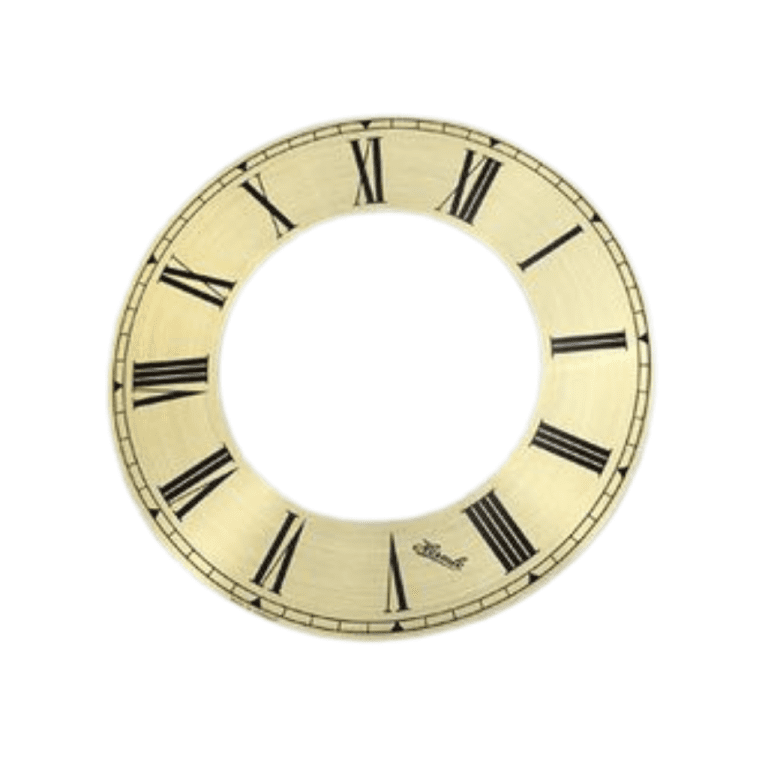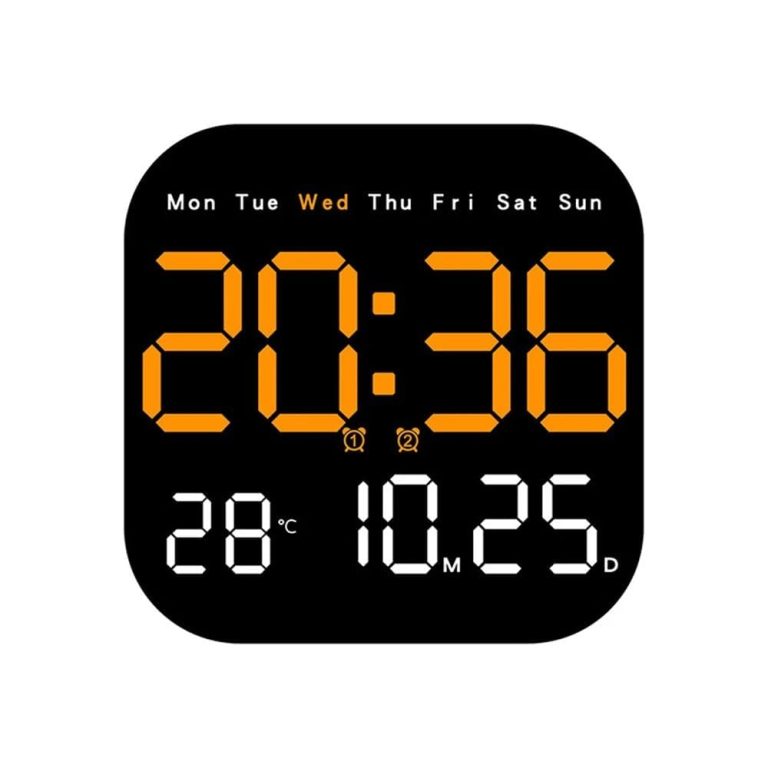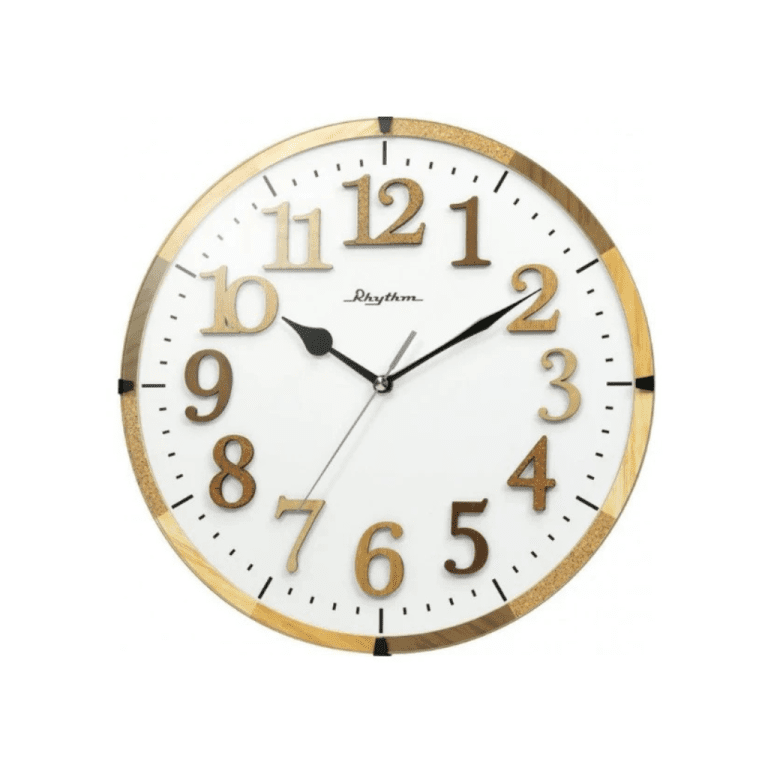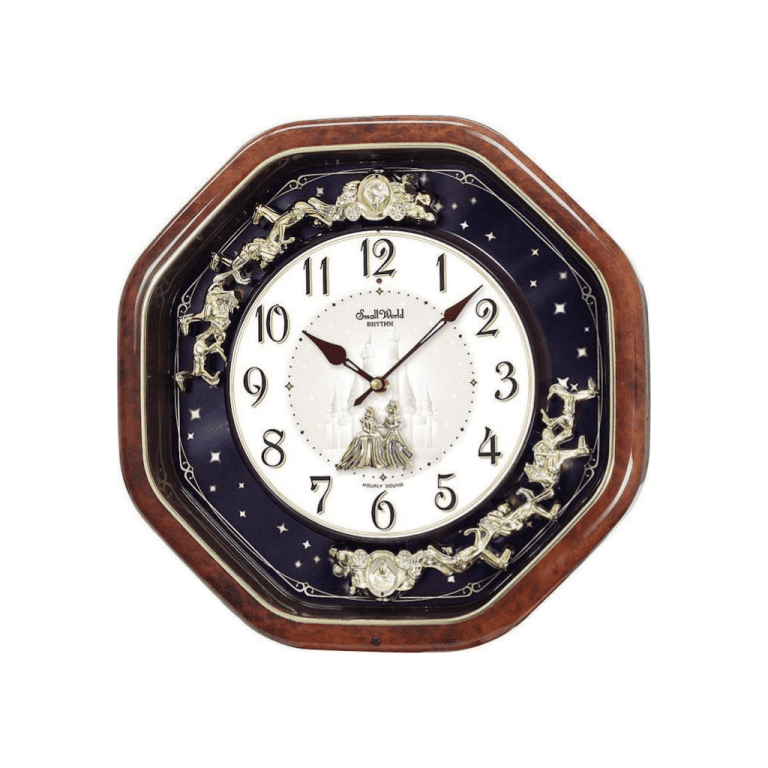BASIC WATCH COMPONENTS
(A) Crown – This is the knob used to set and wind a watch. It is located at 3 O’clock on a normal watch, but it is most often at 12 O’clock on Vortic’s watches because they are powered by pocket watch movements.
(B) Lugs – Lugs come in many shapes and sizes, but they are always what the strap is attached to on the case.
(C) Case – The case houses the watch mechanism and is almost always made from metal. Vortic’s watch cases are 3D printed from metal.
(D) Dial – The face of the watch. This is the physical piece that we see from the front of the watch, usually having numerals or markers that the hands point to.
(E) Crystal – A watch crystal is the glass on the front or back of the watch that allows us to see inside the case. All of Vortic’s watches have Gorilla Glass crystals, but most watch crystals are made from mineral glass or sapphire.
(F) Hands – Watch hands point to features on the dial. They come in many shapes, sizes, and materials.
(G) Sub-Seconds Dial or Small Seconds – Many mechanical watches have a small subdial for the second hand. This is referred to as a “sub-seconds” dial or “small seconds” by many. These subdials can be located anywhere on the main dial, but Vortic’s sub-seconds dials are almost always at 6 O’clock.
(H) Strap – The band that holds the watch case to your wrist.
(I) Movement – This is the mechanism that powers the watch and regulates time.
MECHANICAL VS. QUARTZ
Perhaps the most common knowledge gap in the watch world is the difference between a mechanical watch and a quartz watch. The terms mechanical and quartz refer to the movement of the watch (the movement powers the watch and regulates time).
Quartz
The biggest distinction between mechanical and quartz watches is the use of a battery. Quartz watches are powered by a battery and mechanical watches are powered by gears and springs. You’ll notice that the second hand on a mechanical watch has almost continuous motion while the second hand of a quartz watch ticks once per second.
Mechanical
The highest-end watches in the world are mechanical, and mechanical watches are normally more valuable than quartz watches. However, there are many levels of quality within the families of mechanical watches as well as quartz watches. This means that there are expensive quartz watches and cheap mechanical watches out there as well. All of Vortic’s watches use a mechanical movement to keep time.
QUARTZ WATCHES
When a watch says “Quartz,” it means that the watch is powered by a movement which regulates time through the use of a crystal made out of the mineral quartz. Quartz watches still have gears to turn the hour, minute, and second hands (unless the watch does not have hands, i.e. digital watches), as well as any other complications (explained later), but gears in a quartz watch are turned by an electric stepping motor (a motor that can move a prescribed distance each time it is engaged) that is powered by a battery.
The mineral quartz has the property of being piezoelectric. This means that when any type of mechanical stress is introduced to the material’s structure, it produces an electrical impulse. The opposite is also true, meaning that the material vibrates when charged with electricity.
The basic concept behind a quartz watch movement is relatively simple. A tiny circuit and microchip use a battery to charge a tuning-fork-shaped quartz crystal, causing it to vibrate or oscillate. The microchip is calibrated to measure this vibration in order to regulate an electrical signal that pulses exactly once every second (32,768 oscillations/second!). This electrical pulse tells the stepping motor to turn the hands one second worth of motion.
Quartz is an extremely abundant mineral and the workings of a basic quartz movement are fairly easy to mass produce. Consequently, quartz watches can be produced for very low cost while maintaining a high level of accuracy. Interestingly enough, a quality quartz watch will keep time as good or better than the highest-end mechanical watches.
MECHANICAL WATCHES
A mechanical watch is powered by gears and springs. It uses calibrated motion to regulate time. The basic principle behind a mechanical watch is as follows; the user turns the crown of the watch to wind a spring (called the mainspring), and this spring puts force on the first gear in a train of gears. Similar to a transmission, this gear train uses leverage to reduce the force significantly and apply a small amount of pressure to a mechanism called the escapement. This escapement does exactly what the name suggests; it allows the energy stored in the mainspring to escape very slowly, and it regulates the release of this energy in order to turn the hands of the watch at the correct speed to keep time.
If quartz watches perform similarly to mechanical watches, then why can mechanical watches be so much more expensive?
Mechanical watches were the only way to keep time without a clock nearby before quartz watches were invented. Mechanical watch mechanisms were some of the most advanced technology of their time, and mechanical pocket watches were in such high demand in the late 1800’s and early 1900’s that a massive industry emerged. As a result, many mechanical watches have held their value through pure historical and heritage related factors.
The major functional benefits of mechanical watches are that they never run out of battery and they are not disposable. Quality mechanical watches are made to last forever if taken care of.
There is an overwhelming variety of quality, decoration, and function that distinguishes some watches from other watches in addition to the heritage, tradition, and branding of companies responsible for building those watches. The level of precision, engineering, and detail that goes into fabricating some of the world’s most complicated mechanical watches is difficult to comprehend.
The true value of a mechanical watch in the modern world, however, is the craftsmanship and the story. Humankind has been captivated by feats of elegance and precision for hundreds of years, and mechanical watches represent the epitome of beauty in function. The romance involved with quality mechanical watches continues to infect more people each year, even as the role that watches play in our lives evolves into something much more than keeping time.
MANUAL WIND VS AUTOMATIC
The terms manual wind and automatic refer to the method in which the watch is wound. Quartz watches run continuously when they have a battery inside of them, so they cannot be wound. Only mechanical watches have the distinction of being manually or automatically wound.
A manual wind watch needs to be wound every time the mainspring runs out (i.e. the watch stops running). Twisting the crown is the only way to wind a manual wind watch, and the crown will hit a distinct stopping point when the watch is fully wound. Manual wind watches can be damaged if forcibly over-wound. Every watch in Vortic’s American Artisan Series is manually wound.
An automatic watch has a weighted rotor that winds the watch by harnessing gravity. The rotor wants to be as close to the ground as possible, so when the watch is worn, the motion of your wrist causes the rotor to spin. This is important because when the rotor spins it winds the mainspring. Theoretically, if you wear an automatic watch every day then you will never have to wind it. Automatic watches can also be wound by turning the crown (just like a manual wind watch), but the crown on an automatic watch has no distinct stopping point and can be wound forever without damaging the mainspring.
COMPLICATIONS
A watch complication is anything that performs a function above and beyond keeping time. Below are images and descriptions of common complications.
Day/Date – A day/date complication displays the day of the week, the calendar date, and sometimes the month. Simple day/date mechanisms have a standard month length of 31 days and need to be reset each month. Advanced date complications take short and long months into account, and can be accurate for a year when running continuously (called an annual calendar watch). Ultra advanced date complications even take the leap year into account and will display an accurate date for many years (called a perpetual calendar watch).
Tourbillon – Pronounced “Tour-Be-Yon,” a tourbillon is not necessarily a complication because its function is to improve the timekeeping of the watch. However, a tourbillon is still one of the most complicated mechanisms in the world of horology. A tourbillon reduces the negative effects of gravity on the timekeeping of a mechanical watch by placing the balance wheel (the most rapidly moving part of a mechanical watch) in multiple positions, even while the watch is stationary. This averages out the error due to gravity and makes the watch more accurate over time. A basic tourbillon rotates on one axis while double and triple tourbillon complications, often placed in the category of grand complications, rotate the balance wheel on two and three axes.
Chronograph – In its most basic form, a chronograph is a stopwatch. A chronograph watch usually has a hand or subdial to record the seconds elapsed and another subdial to record the minutes elapsed. Modern chronographs have two buttons surrounding the crown; a button to start and stop the chronograph and a button to reset it. More advanced chronographs have variations on the way that the buttons actuate the chronograph, but the original chronographs had one simple button to start, stop, then reset the mechanism in that order.
Power Reserve Indicator – A power reserve indicator watch has a subdial that shows how much wind or run time is left on the watch. Some of the highest-end railroad pocket watches had a power reserve indicator that was usually referred to as an up-down indicator (it was either more wound up or more wound down).
Chronometer – A chronometer is an extremely precise watch that has passed a prescribed set of accuracy tests. Swiss watches must go through the COSC (Contrôle Officiel Suisse des Chronomètres) to obtain the chronometer distinction. The COSC is a testing institute that observes watches for multiple days in various orientations and temperatures. If a mechanical watch does not stay in a range of -4 to +6 seconds of variation per day then it fails. Marine chronometers are a specific category of chronometer that comes in the form of an extremely accurate clock suspended in a gyroscopic box. Marine chronometers were often used on ships to help determine location.
GMT – The name is derived from the term Greenwich Mean Time, created in the 1880’s to be the center of time for the world. The GMT watch function allows users to track two time zones simultaneously. Normally, a GMT watch has an hour, minute, and second hand as well as a “GMT hand” that completes a full cycle in 24 hours rather than the normal 12 hours. The GMT hand points to a separate 24-hour dial and can be set to a different time zone than the regular hands. The earliest GMT watches simply geared the GMT hand to rotate at half the speed of the hour hand, and a rotating bezel with 24 hour markers on it was used to set the second time zone. More advanced, modern GMT watches allow for independent adjustment of the local and GMT time. The two-tone bezel on the watch below is meant to represent night and day for the GMT time.
Moon Phase – A moon phase watch tracks the lunar cycle using a dial and curved aperture (viewing window). The cycle from new moon to waxing moon to full moon to waning moon then back to new moon, takes about 29.5 days. The moon dial in a basic moon phase mechanism is turned by a gear with 59 teeth that gets rotated one notch every 12 hours. Technically the lunar cycle takes 29.53 days, so a standard 59 tooth mechanism will be off by one day every two and a half years. The more advanced a moon phase mechanism is, the longer it will be correct without the need to manually change it.
Repeater – Repeater mechanisms were created so that users could hear the time when unable to see the face of their watch. When the repeater button is pressed, the watch “repeates” the time using a chime. Like a chiming clock, an hour repeater would chime 10 times if it’s 10:24 or 10:53, a quarter repeater will chime out the quarter hours in addition to hours, a 5 minute repeater will chime out the 5 minute intervals following the hour, and a minute repeater (the pinnacle of repeaters) will chime out the time down to the minute. Some mechanisms even use different chimes to distinguish between hours and smaller intervals.
MOVEMENT COMPONENTS
Mechanical watch movements come in many shapes and sizes, but the basic timekeeping principle has not changed for more than 100 years. Every mechanical watch has a mainspring, a gear train, and an escapement. Below, we will label the core parts of a manual wind watch movement.
(A) Balance Wheel – The balance wheel is the component that oscillates or rotates. It must be almost perfectly balanced, as the name suggests, for the watch to keep good time. The staff that the balance wheel rotates around is necessarily very delicate, and it can be broken given enough force from a drop or fall. There is a very small “hairspring” coiled around the staff that determines the rate at which the balance oscillates.
(B) Pallet Fork – The pallet fork is a small trident-shaped piece that pivots back and forth to connect the balance wheel to the gear train. It “flicks” an impulse jewel on the balance wheel each time the watch ticks to maintain the rate of the balance. The actual ticking sound you hear is the two pallet jewels (rectangularly shaped jewels in the pallet fork) interacting with the uniquely shaped teeth of the escape wheel of the gear train.
(C) Escape Wheel – The escape wheel is the last stage of the gear train. Its teeth are shaped in such a way that each time the watch ticks, the pallet fork changes direction and allows the escape wheel to move one tooth worth of rotation.
(D) Gear Train – The gear train is what connects the mainspring or barrel (the power source) to the escapement (the time regulating mechanism). It reduces the mainspring’s power so that a small amount of wind translates to many hours of run time.
(E) Jewels/Jewel Settings – Not every watch has jewels, many watches have a different amount of jewels, and jewels come in different forms, but most jewels act as bearings that the gears spin around. The jewels are almost always made from ruby or sapphire, which are desirable materials for use in watch mechanisms because they don’t wear. Artificially synthesized jewels are used because their crystalline structure is perfect every time, unlike authentic jewels that are sometimes more valuable for their flaws. A fully jeweled manual wind watch with no complications has 17 jewels (12 bearings, 2 balance cap jewels, 2 pallet jewels, and 1 impulse jewel).
(F) Regulator – The regulator is located on the top of the balance bridge and can be adjusted to make small changes in the timekeeping of the watch. The regulator is attached to the hairspring and effects the timekeeping by shortening or lengthening the hairspring.
(G) Balance Bridge or Balance Cock – This is the bridge that holds the bottom jeweled bearing for the balance wheel.
(H) Bridges – The bridges of the movement retain the components of the watch to the main plate.
(I) Barrel/Mainspring – The barrel contains the mainspring that powers the watch. The mainspring is wound around an arbor inside the barrel which is also connected to the gear we see on the bottom of the movement.
(J) Winding Wheel – This is the gear that connects the winding components to the mainspring. This wheel spins when you wind the watch.
Credited to: vorticwatches


